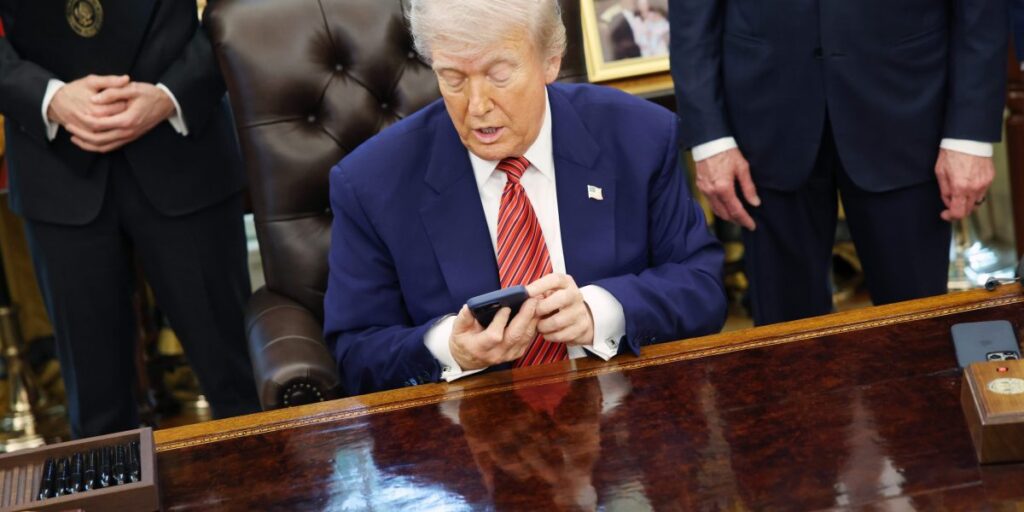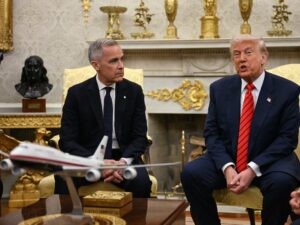
Analysts and supply chain experts are casting doubt on the Trump Organization’s claims that its new smartphone will be “built in the United States.” Despite the company’s assertions, it appears more likely that the $499 device will be produced in China. This revelation comes as the Trump Organization announced on Monday its plans to license its name to a new wireless service called Trump Mobile, featuring a gold-colored “T1” smartphone set for release in August.
The Trump Organization, a conglomerate known for its real estate, hospitality, and entertainment ventures, is partnering with Liberty Wireless to operate the T1 on the Google Android system. While the announcement proudly declared the phones as “designed and built in the United States,” industry experts believe the manufacturing will initially be outsourced to an original device manufacturer (ODM) overseas.
Manufacturing Realities and Expert Opinions
Blake Przesmicki, an analyst at Counterpoint Research, noted, “Despite being advertised as an American-made phone, it is likely that this device will be initially produced by a Chinese ODM.” The United States currently lacks the manufacturing capabilities to produce the phone domestically, he explained. Even if it did, the company would still need to import key components from abroad.
Eric Trump, executive vice president of the Trump Organization, acknowledged on The Benny Show podcast that Trump Mobile would not be entirely domestic at first. “Eventually, all the phones can be built in the United States of America,” he stated, suggesting that initial production or assembly could occur overseas before the August launch.
Challenges in U.S. Manufacturing
President Donald Trump has been a vocal advocate for boosting domestic manufacturing, imposing tariffs to encourage production within the U.S. However, experts have long warned about the limitations of American manufacturing infrastructure. Dan Ives, an analyst at Wedbush Securities, previously highlighted the challenges faced by companies like Apple, which established its supply chain in China decades ago. Moving production to the U.S. would necessitate costly sourcing changes and labor expenses, potentially driving the price of a U.S.-made iPhone to over $3,000.
“Generally, no phones have been manufactured in the U.S. since the 2G era in over a decade,” Przesmicki told Fortune. “We have weaker supply chains, fewer capable employees in the smartphone sector, lower margins.”
If any Trump-branded phones are manufactured in the U.S., Przesmicki suggests it would be on a limited scale, likely fewer than 1,000 units. Leo Gebbie, principal analyst at CCS Insight, expressed skepticism about the feasibility of U.S. production before the August launch, calling it “an absolute pipe dream.”
Implications of Tariffs on Production
The Trump Organization’s strategy of importing components for final assembly in the U.S. may allow it to claim the phones are “built” domestically, but it also exposes the company to tariffs imposed by the Trump administration. These tariffs were designed to discourage trade with China, yet they now pose a potential obstacle for the Trump Organization itself.
“This absolutely does raise the specter of the Trump Organization mobile falling foul of the tariffs that have been instigated by the Trump administration,” Gebbie said.
The majority of smartphone components, including screens, cameras, and processors, are manufactured in Asia. President Trump recently threatened a 25% tariff on smartphones not produced in the U.S., targeting companies like Apple for their overseas production. This policy could complicate the Trump Organization’s plans if they continue to rely on imported parts.
Strategic Messaging and Industry Impact
Despite the challenges, the Trump Organization’s emphasis on U.S. production may serve a strategic purpose. Gebbie suggested that the company’s messaging could be intended to pressure major tech companies like Apple and Samsung to consider U.S. assembly. “Maybe it provides leverage for the Trump administration to go out to device-makers and say, ‘Hey, we are making smartphones in the U.S. Why aren’t you?’” Gebbie proposed.
As the August launch approaches, the Trump Organization faces significant hurdles in aligning its production capabilities with its marketing promises. The outcome of this endeavor could influence broader discussions on the feasibility and cost of domestic smartphone manufacturing in the U.S.





